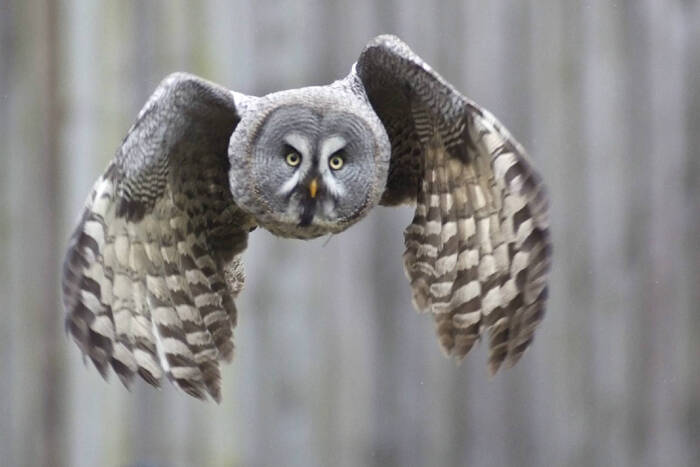Strix davidi
IUCN
LCBasic Information
Scientific classification
- name:Strix davidi
- Scientific Name:Strix davidi,Sichuan wood owl,Hum, cat-bird, owl
- Outline:Raptor
- Family:Strigiformes Owl
Vital signs
- length:54cm
- Weight:500-800g
- lifetime:5-15years
Feature
Very similar to the exotic long-tailed forest owl
Distribution and Habitat
A rare resident bird with a very narrow distribution area, it is distributed in southeastern Qinghai, northern, central and western Sichuan, and southern Gansu Province, from open coniferous forests and subalpine mixed forests at an altitude of 2,700 to 4,200 meters. It is the only Strigiformes bird with endemic distribution in China.
Appearance
No ear tufts, grey face, brown eyes. Looks like a large grey owl, but with simpler vertical stripes on the underside. Very similar to the exotic long-tailed owl, but with different body feathers, usually darker. Iris - brown; bill - yellow; feet - feathered with grey and brown horizontal stripes. Calls similar to the long-tailed owl.
Details
Sichuan wood owl, also known as Sichuan wood owl in English, is a large gray-brown owl with no subspecies.

The Sichuan Forest Owl is sometimes considered a subspecies of the Long-tailed Forest Owl, but due to long-term geographical isolation from other Long-tailed Forest Owl subspecies, more and more literature suggests that the Sichuan Forest Owl has evolved independently into a separate species.
The Sichuan Forest Owl lives in coniferous forests above 2500m above sea level, and occasionally appears in secondary forests and sparse forests at the edge of forests. Except for the breeding season when it moves in pairs, it usually moves alone. During the day, it mostly lives in the depths of dense forests, standing upright on horizontal thick branches close to tree trunks. Because its body color is very similar to the color of the tree, it is difficult to be discovered although it is not very hidden. Sometimes it also moves and hunts during the day. In the cold winter, it often hides in tree holes to avoid wind and snow, and sometimes even knocks on tree trunks without flying out. It is mostly active in the middle and upper layers of the forest, and only flies over the tree canopy when flying long distances. When flying, the two wings flap with a large amplitude, and the flight is light and silent. It often flies in a wave-like manner. Generally, the flight distance is not far, and each time is about 50 to 60 meters. It calls frequently during the breeding season, and male and female birds use calls as a medium of communication. The call is deep and far-reaching, and the range of transmission is wide. It mainly feeds on pikas, Gansu hamsters, etc., and also eats some other birds.
The breeding season of Sichuan Forest Owl is from March to June. It usually nests in larger tree holes, and also nests on higher cliffs. Each nest lays 2 to 4 eggs. The eggs are white. The female bird is responsible for incubation. After the first egg is laid, it starts incubation, and the incubation period is 27 to 28 days. The chicks are late-maturing. From the time they hatch to the time they are about 10 years old, their feathers are white and covered with down feathers. The chicks leave the nest after about 30 to 35 days. The male bird provides food during the breeding season. The female bird is in close contact with the male bird during the brooding period, taking on tasks such as warming the chicks, feeding, and protecting the nest. In the first few months after the chicks fly for the first time, the female bird is in close contact with the chicks, taking on the responsibility of warning and guiding them. During this period, food is mainly provided by the male bird. It is not until late autumn that the chicks lose their down feathers and begin to migrate to their wintering grounds.
Listed as vulnerable in the Birdlife International Red List
Protect wild animals and stop eating game.
Maintaining ecological balance is everyone's responsibility!








